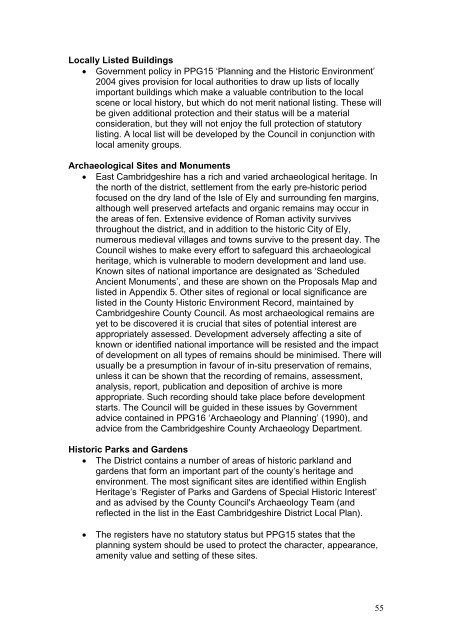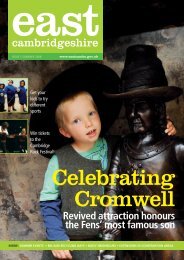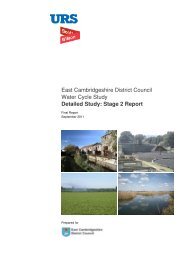6. Soham Conservation Area - East Cambridgeshire District Council
6. Soham Conservation Area - East Cambridgeshire District Council
6. Soham Conservation Area - East Cambridgeshire District Council
Create successful ePaper yourself
Turn your PDF publications into a flip-book with our unique Google optimized e-Paper software.
Locally Listed Buildings<br />
• Government policy in PPG15 ‘Planning and the Historic Environment’<br />
2004 gives provision for local authorities to draw up lists of locally<br />
important buildings which make a valuable contribution to the local<br />
scene or local history, but which do not merit national listing. These will<br />
be given additional protection and their status will be a material<br />
consideration, but they will not enjoy the full protection of statutory<br />
listing. A local list will be developed by the <strong>Council</strong> in conjunction with<br />
local amenity groups.<br />
Archaeological Sites and Monuments<br />
• <strong>East</strong> <strong>Cambridgeshire</strong> has a rich and varied archaeological heritage. In<br />
the north of the district, settlement from the early pre-historic period<br />
focused on the dry land of the Isle of Ely and surrounding fen margins,<br />
although well preserved artefacts and organic remains may occur in<br />
the areas of fen. Extensive evidence of Roman activity survives<br />
throughout the district, and in addition to the historic City of Ely,<br />
numerous medieval villages and towns survive to the present day. The<br />
<strong>Council</strong> wishes to make every effort to safeguard this archaeological<br />
heritage, which is vulnerable to modern development and land use.<br />
Known sites of national importance are designated as ‘Scheduled<br />
Ancient Monuments’, and these are shown on the Proposals Map and<br />
listed in Appendix 5. Other sites of regional or local significance are<br />
listed in the County Historic Environment Record, maintained by<br />
<strong>Cambridgeshire</strong> County <strong>Council</strong>. As most archaeological remains are<br />
yet to be discovered it is crucial that sites of potential interest are<br />
appropriately assessed. Development adversely affecting a site of<br />
known or identified national importance will be resisted and the impact<br />
of development on all types of remains should be minimised. There will<br />
usually be a presumption in favour of in-situ preservation of remains,<br />
unless it can be shown that the recording of remains, assessment,<br />
analysis, report, publication and deposition of archive is more<br />
appropriate. Such recording should take place before development<br />
starts. The <strong>Council</strong> will be guided in these issues by Government<br />
advice contained in PPG16 ‘Archaeology and Planning’ (1990), and<br />
advice from the <strong>Cambridgeshire</strong> County Archaeology Department.<br />
Historic Parks and Gardens<br />
• The <strong>District</strong> contains a number of areas of historic parkland and<br />
gardens that form an important part of the county’s heritage and<br />
environment. The most significant sites are identified within English<br />
Heritage’s ‘Register of Parks and Gardens of Special Historic Interest’<br />
and as advised by the County <strong>Council</strong>'s Archaeology Team (and<br />
reflected in the list in the <strong>East</strong> <strong>Cambridgeshire</strong> <strong>District</strong> Local Plan).<br />
• The registers have no statutory status but PPG15 states that the<br />
planning system should be used to protect the character, appearance,<br />
amenity value and setting of these sites.<br />
55






